- Moderator
- #121
- Joined
- Nov 9, 2000
- Messages
- 7,544
- Location
- Edgerton, Ohio, United States
- Corvette
- 1959 black 270hp (9/2/69) 1981 Beige L81(10/20/80)
What a great thread. Lots of good tips too. I recently had a bad experience with photo processing at a local store. I've used them before and got the DVD made too so it's easy to post pictures. Overall they have been ok for what I was using the photos for. Well guess what? They don't have the film picked up by a courier any more. Now it's mailed and it got x-rayed. All of my NCRS Indiana Regional pictures except the digital ones were ruined. I drug my Canon F1 and all of it's lenses and accessories to Auburn for nothing.
I guess the lesson learned is know your lab and don't get lazy. By that I mean I should have driven my film to the pro lab in Ft. Wayne that I used to use when I lived there. I just didn't want to spend the time doing it.
Kodak has some new professional film I want to try too but I have to go to Ft. Wayne to get that. Looks like a trip is in the works.
I use my tripod indoors and out. The older I get the harder it is to hold the camera just like I want. I set the height and angle then set the camera settings. The F1 is a fully manual camera but that is how I learned way back. I also use the timer to trip the shutter. That way no hand are on the camera when it trips. A cable release works well too but my digitals don't have any provision for that.
Another thing that is a good tool to take along is some reflective panels. Early or late in the day gives you the best lighting and color but you often get shadows where you don't want them or you may want the sunset in the background ect. The flash on the camera isn't always the direction that you need light to come from. Take some cardboard that you can fold and cover it with aluminum foil, shiny side out. You can make as many of these as you want in several sizes. With a little though and some various lengths of wooden dowel rods and maybe a folding easel that is easy to store in the car, you can have panels that you can position where you need them to reflect light onto your car exactly where you need it. The cost is almost nothing too.
If you still like to play with film like I do take your digital along and use it to set up you composition and lighting since you have instant results. Then take a few with the film camera bracketing the exposure to be sure you end up with the look that you want.
I just got a new digital that I haven't had the chance to play with too much. It's a huge improvement over my old one and does macro right up there with my Canon macro lens. I'm impressed. If the global warming hold out a little longer this year I may be able to get the car out for some pics.
Tom
I guess the lesson learned is know your lab and don't get lazy. By that I mean I should have driven my film to the pro lab in Ft. Wayne that I used to use when I lived there. I just didn't want to spend the time doing it.
Kodak has some new professional film I want to try too but I have to go to Ft. Wayne to get that. Looks like a trip is in the works.
I use my tripod indoors and out. The older I get the harder it is to hold the camera just like I want. I set the height and angle then set the camera settings. The F1 is a fully manual camera but that is how I learned way back. I also use the timer to trip the shutter. That way no hand are on the camera when it trips. A cable release works well too but my digitals don't have any provision for that.
Another thing that is a good tool to take along is some reflective panels. Early or late in the day gives you the best lighting and color but you often get shadows where you don't want them or you may want the sunset in the background ect. The flash on the camera isn't always the direction that you need light to come from. Take some cardboard that you can fold and cover it with aluminum foil, shiny side out. You can make as many of these as you want in several sizes. With a little though and some various lengths of wooden dowel rods and maybe a folding easel that is easy to store in the car, you can have panels that you can position where you need them to reflect light onto your car exactly where you need it. The cost is almost nothing too.
If you still like to play with film like I do take your digital along and use it to set up you composition and lighting since you have instant results. Then take a few with the film camera bracketing the exposure to be sure you end up with the look that you want.
I just got a new digital that I haven't had the chance to play with too much. It's a huge improvement over my old one and does macro right up there with my Canon macro lens. I'm impressed. If the global warming hold out a little longer this year I may be able to get the car out for some pics.
Tom




 Jane Ann
Jane Ann





